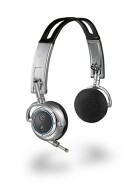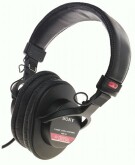User Opinions
|
||||||||||
|
|
|
| Tue Feb 27, 2007 - 8:15 AM EST - By Harv Laser | |
|
|
|
|
|||||||||||
Note: Click on any picture in this review to view it full-sized in a new window

The Plantronics Pulsar 590a Bluetooth Stereo Headphones / Headset are probably the highest-tech headphones I've ever owned � not only do they have a futuristic, space-age look, but they incorporate more technology than any others I've ever used. Notice I didn't say they SOUND better than any headphones I've ever owned, but before I get into the meat of reviewing them, please indulge me while I backtrack and give you some my own history so you know where I'm coming from when I talk about HiFi, one of my life-long passions.
I'm serious about quality sound reproduction. Cheap no-fi equipment just annoys me. I've owned a lot of stereo gear and headphones since I first got into HiFi in the 1960s. My first "cans" were purchased out of necessity � during high school and college, I lived with my folks, and although I had a pretty respectable stereo rig whose components I constantly upgraded when I could afford to (a beefier amp, better speakers, turntable, tape decks and so on).. the folks didn't appreciate the sound of sixties rock blasting from my bedroom.
Remember, this was long before personal computers existed, so my friends and I spent what we could on our sound systems, always striving for the best sound we could afford. We read Stereo Review and High Fidelity magazines and argued endlessly about what we owned, what we wanted to buy next, and the hyper-expensive gear that none of us could afford.
Every generation is usually repelled by, and describes their descendants' taste in music as "noise".. I have to admit I'm guilty of the same thing. I watch the Grammy awards and I think to myself "who are all these artists? I've never heard of them! This is music?"
I've turned into my parents. Much of today's music favored by those in their teens and twenties sounds like nothing more than noise to me, and I still prefer and love classic, progressive rock (The Beatles, Stones, Hendrix, Genesis, Pink Floyd, and countless other artists and groups of my youth since for me, and probably for you too, special memories are attached to the music you enjoyed with your friends when we were younger). So to avoid that banging on the bedroom door and shouts of "turn that noise down!" bellowed by my folks, I relegated most of my listening time when they were home to headphones, and my speakers when they weren't.
I hate to come off sounding like an old fogey, but back then we had records, tapes, and the radio and that was it. The technology we take for granted today was decades away. Audio CDs didn't appear until 1982, and no one ever heard of MP3 or the other digital audio file formats before about 1990. So as my income grew, and I kept upgrading my gear, I went through many sets of increasingly better, more expensive headphones with wider frequency response, and cleaner, more accurate sound. It's the same today with apartment living and paper-thin walls. I'd love to crank up the stereo. I'd love not to get evicted too, so most of my serious listening is still done with headphones.
Audiophiles get absolutely religious when they discuss headphones and many Web sites are devoted to such debates. Which sound the best? Which give the most bang for the buck? Headphone quality, both ergonomically (what's comfy) and sonically (what sounds good) is a very personal, subjective thing, and I won't get into all the reasons why some cans sounds sweet to one person and like junk to another. One man's garbage is another man's prune Danish, but you'll have to take my word for it - that's just the way it is. I know what I like but I don't expect or insist you agree with my tastes.
As technology started shrinking and digital took over, the ubiquitous iPod became the de-facto standard of portable players, and earbud-style headphones grew in popularity. Well I'll tell ya, I've never been a fan of earbuds. Whether they're tossed in free with a player, or one of the expensive models, for me, they're just uncomfortable, they fall out of my ears, and no matter what kind they are, or how much they cost, they simply don't sound as good to me as a quality pair of headphones.

Not that many years ago, all headphones, whether they cost ten bucks or a thousand, had one thing in common � they were hard-wired; to use them, you had to plug them into some kind of audio gear with a jack dangling from the end of a straight or coiled cord.
Sure, cordless / wireless headphones have been around for a while, but generally speaking, they were an expensive, and somewhat esoteric solution that varied wildly in quality and were typically many times more expensive than wired models that delivered similar quality sound. Again, and I can't emphasize this enough, headphones are a very personal thing, but for me, my cans of choice, my benchmark are the Sony MDR-V6. At under a hundred bucks, I've never heard better sounding headphones at any price. I bought a pair twenty years ago and still use them. With a frequency response of 5hz � 30khz, prodigious bass, super accurate (some might describe them as "clinical", I call them "neutral") sound, comfy headband, long coiled cord and their circumaural (around the ear) design, I've spent thousands of hours with those black beauties on my head, and as I've mentioned in other reviews, there aren't many models of anything that Sony's made for over two decades. There must be a reason. But they're still "old-fashioned" headphones. They don't have any controls on them, and to use them, you plug them into the audio source of your choice and that's that.
When the opportunity arose to get my claws on, evaluate, and review a pair of state-of-the-art headphones, the Plantronics Pulsar 590a, (for brevity's sake I'll just call them the Pulsars for the rest of this review).. I jumped at the chance. Like I said, I'm a headphone junkie and despite getting older, my hearing is still "20/20". I think I know quality sound reproduction when I hear it.
Besides, this is TreoCentral, and while you or I probably own other headphones or headsets, the Pulsars are Plantronics' answer to a top-of-the-line, "do everything" set of headphones that operate wired or wirelessly, and double as a Bluetooth headset for calls.
Packaged in a huge, impressive window box, you'll find a literal cornucopia of stuff inside:

The Pulsars, with their adjustable over-the-head band, and softly cushioned supra-aural (rest atop your ears) pads are a very attractive, extremely versatile product that are not only festooned with more controls than I've ever seen on a pair of headphones, but come with every accessory you could possibly need to use them for their two main functions � listening to audio, and using them as a Bluetooth wireless headset for calls.
Plantronics touts the Pulsars with these specifications (based on their internal L-ion polymer battery fully charged)..
These figures are respectable, although I wouldn't classify them as "spectacular."
What sets the Pulsars apart from standard, wired headphones when used with a Treo is their ability to switch seamlessly from stereo audio listening to phone calls and back again.
And their included "Universal Adapter" lets you use them as wireless headphones with ANY audio gear you can name.
Because they're a multi-purpose headphone, it's hard to know exactly where to start to describe how to use them, but let's give it a shot.
Copyright 1999-2016 TreoCentral. All rights reserved :
Terms of Use : Privacy Policy
TREO and TreoCentral are trademarks or registered trademarks of palm, Inc. in the United States and other countries;
the TreoCentral mark and domain name are used under license from palm, Inc.
The views expressed on this website are solely those of the proprietor, or
contributors to the site, and do not necessarily reflect the views of palm, Inc.
Read Merciful by Casey Adolfsson